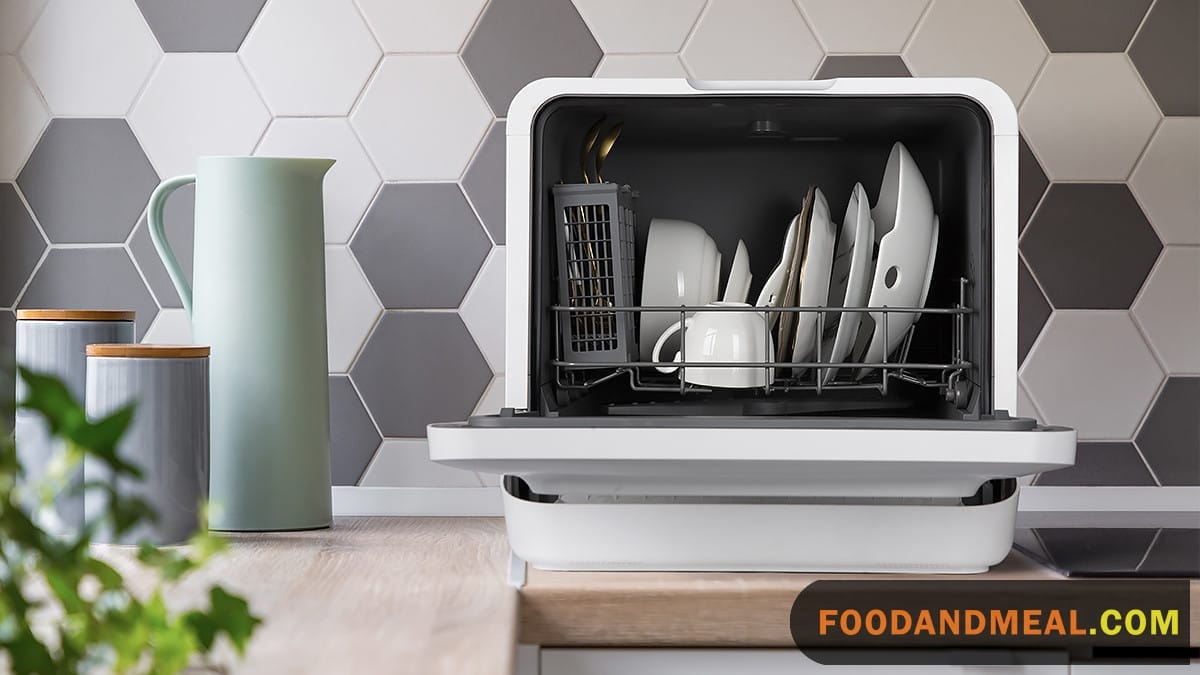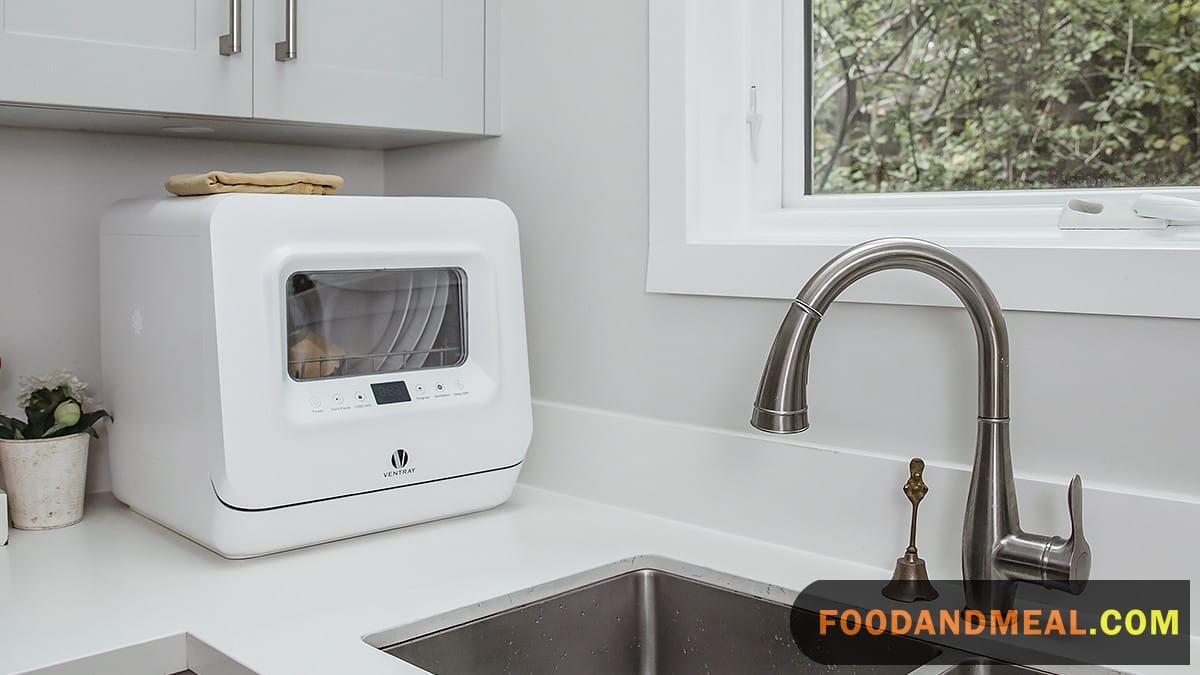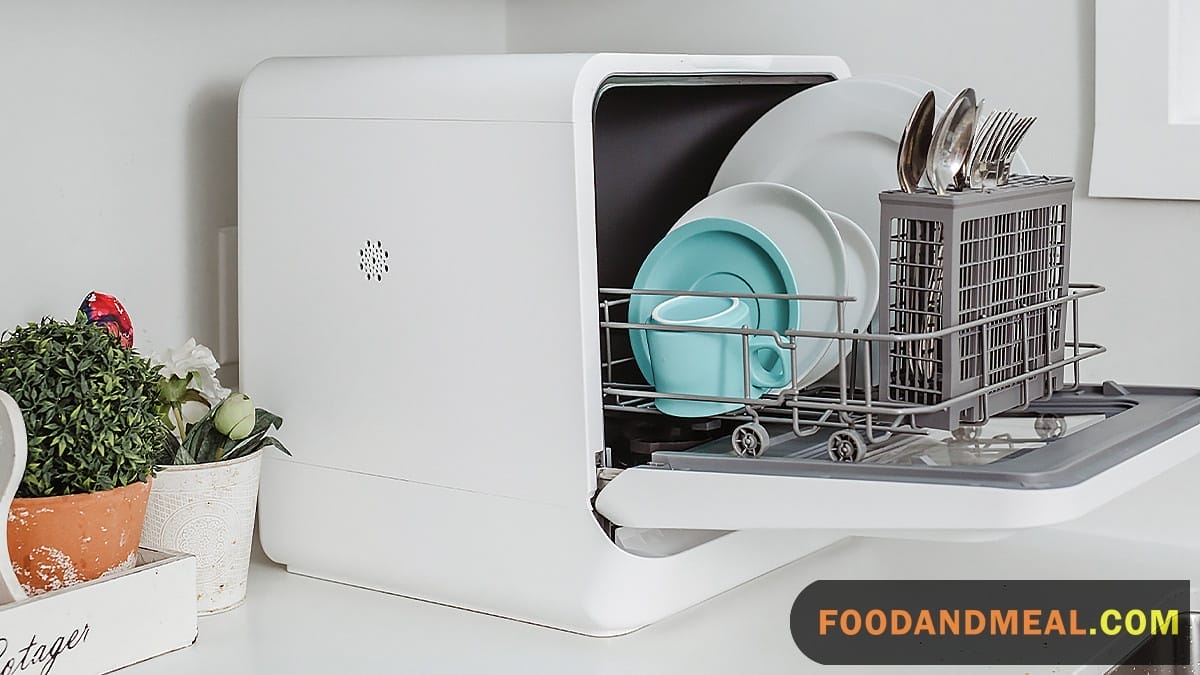Even in the confines of a compact kitchen, the convenience of an automated dishwasher can prove beneficial. A portable or countertop dishwasher serves as a practical alternative to manual dishwashing. The permanent installation of a countertop dishwasher may seem challenging, requiring specific modifications.
Therefore, Food and Meal have meticulously gathered information from various sources to provide you with clear and user-friendly instructions for successfully How to install a countertop dishwasher. By adhering to these step-by-step instructions and our suggested tips, you can easily accomplish the installation process and enjoy the convenience of your new appliance.

Planning for Your Countertop Dishwasher
Securely connecting your countertop dishwasher to your plumbing requires a few minor adjustments. While installing a countertop dishwasher is not as intricate as installing a built-in model, there are still essential steps to ensure optimal results.
Countertop or portable dishwashers may raise concerns regarding placement, operation, and durability. Therefore, it’s crucial to plan two primary placement options before initiating the installation process.
- On the countertop: If you position your countertop dishwasher on top of your counter, you can utilize existing electricity. The dishwasher will be linked to plumbing beneath your counter and connected to an available outlet above your countertop.
- Under the counter: Placing the dishwasher under the counter conserves counter space but may require adding a power source beneath the counter for operation. If you prefer not to install an electrical outlet beneath your sink, an alternative is to drill a hole in your countertop and route the electrical cable to an outlet positioned above it.
6 Steps to Installing Your Countertop Dishwasher
Setting up your countertop dishwasher is a breeze. In fact, you’re just six steps away from running your first load of dishes.
Ensure a smooth countertop dishwasher installation by following these straightforward steps:
Step 1: Positioning Your Dishwasher on the Countertop
Embarking on the countertop dishwasher installation journey begins with a straightforward yet crucial step—placing it on the countertop.
While this may seem like a simple task, a strategic placement is essential. Your countertop dishwasher requires ready access to a sink for water supply and drainage. Therefore, it is advisable to install it in close proximity to your kitchen sink.
Equally important is the consideration of a nearby power outlet. To ensure seamless functionality, it’s recommended to position your dishwasher within easy reach of both a power outlet and the sink.
Step 2: Connect the Water Inlet to the Faucet
For the correct installation of your countertop dishwasher, it’s crucial to establish a connection between the water inlet and your kitchen faucet.
Identifying the water inlet hose is simple; look for the one with a threaded connection, typically larger than the other hose. To seamlessly connect your water inlet to the kitchen faucet, follow these steps:
- Turn off the water faucet: Before beginning the connection process, ensure that the water faucet is in the off position.
- Secure the water inlet to the dishwasher: Check that the water inlet is connected to the back of your dishwasher. If not, fasten it securely by screwing the hose to your dishwasher. To enhance the connection in your tabletop dishwasher plumbing setup, it’s advisable to use pliers for tightening.
- Thread the water inlet to the kitchen faucet: If you have a modern faucet, using a faucet adapter is recommended. However, if your faucet features a secondary outlet behind it, you can connect the water inlet to it, allowing you to use the faucet while your countertop dishwasher is running. Ensure that the secondary faucet is in the “off” position before attempting to connect the hose.
Note: If you are connecting the hose to a faucet that is lower than your countertop dishwasher, a pump may be necessary to maintain a consistent water flow. If connecting the hose to your kitchen sink faucet is not feasible, consider attaching it to a water tank as part of your alternative dishwasher plumbing strategy.*
By establishing a proper connection between the water inlet and the faucet, you guarantee a smooth flow of water, ensuring the optimal function of your dishwasher’s water valve when prompted by the control board.

Step 3: Put the Drainage Hose Into the Sink
The subsequent step in the countertop dishwasher installation involves linking the drainage hose to the sink.
Once your countertop dishwasher completes the dishwashing cycle, the control board activates the drain pump, propelling the used water through a drainage hose that directs it into your sink.
Here’s how to set up the drainage hose:
- Ensure the drain hose is connected to the back of your dishwasher: Confirm that the drain hose is securely connected to the back of your countertop dishwasher. If not, fasten it by screwing it onto the back of the unit. Utilizing pliers to tighten the connection is recommended for a secure tabletop dishwasher plumbing setup.
- Place the hose face down into the sink: Direct the drainage hose into the sink, positioning it with the hose facing downward.
When installing the drainage hose, keep the following considerations in mind:
- The drainage hose must flow downward from your dishwasher. Failure to do so could result in dirty water draining back into your countertop dishwasher, potentially causing leaks if the unit overfills. Moreover, allowing dirty water back into the dishwasher can leave your dishes dirtier than before.
- Maintain a distance between the drainage hose and the sink’s plughole. Keep it a few inches away from the plughole, ensuring it remains in the sink. This precaution prevents submersion when the sink begins to fill with water. Properly positioning the hose in this manner ensures that wastewater does not back up into the unit during drainage.
Step 4: Open the Water Faucet
Engaging the Water Faucet in the Countertop Dishwasher Installation Process
As you advance in the installation of your countertop dishwasher, a pivotal moment arises—the activation of the water faucet. This step is essential to confirm the seamless integration of the inlet hose and to assess for any potential leaks.
To ensure a trouble-free setup, meticulously follow these key checks:
- Open the water faucet before connecting the dishwasher to power: Before plugging in your countertop dishwasher, initiate the process by opening the water faucet. This preliminary action serves a dual purpose: first, it allows you to ascertain the correctness of the inlet hose connection, and second, it enables you to check for any signs of leaks.
- Conduct checks in the event of a leak: In the event of a leak, act promptly by turning off the water supply. Subsequently, unscrew the hose and carefully reestablish the connection. Should the need arise, employ pliers to tighten the connections securely. Following these adjustments, reopen the water faucet to validate that the connection is now watertight. Only proceed to the next step when you are certain that there are no leaks.
This methodical examination not only ensures the proper and leak-free connection of the water inlet hose but also provides an opportunity to address and rectify any issues before advancing to the subsequent steps in your countertop dishwasher installation.

Step 5: Plug Your Dishwasher In
Upon completing the installation of your countertop dishwasher, the next step is to connect it to the electrical outlet using the main cable situated behind the unit.
Exercise caution and avoid contact with water while plugging in your countertop dishwasher to mitigate any potential electrical hazards.
Take the following steps to ensure a proper connection:
- Plug it into the wall outlet: Utilize the main cable located at the back of the unit to connect your countertop dishwasher to the wall outlet. Exercise care to prevent contact with water during this process.
- Address power issues: If your countertop dishwasher fails to turn on, first inspect the cable for any damage. Additionally, check the circuit breaker to ensure it is in the correct position.
Once the appliance is successfully connected, proceed to load your dishwasher, preparing it for its inaugural use in the subsequent step.
Step 6: Turn a Cycle On
As the final step in the installation process, I highly recommend initiating a dishwasher cycle on your newly installed countertop unit to ensure its correct setup and functionality.
Follow these detailed steps for a comprehensive test run:
- Prepare the Soap Tray: Fill the soap tray with an appropriate dishwasher detergent. Take into consideration the water hardness in your area; if you reside in an area with hard water, it’s advisable to add salt before the soap. This preemptive measure helps counteract the potential adverse effects of hard water on your dishes and the dishwasher.
- Navigate Dishwasher Controls: Locate and utilize the controls on the front of your countertop dishwasher to start a dishwasher cycle. Familiarize yourself with the various settings, such as wash cycles and temperature options, ensuring you select the desired configuration for your specific dishwashing needs.
- Observation during the First Wash: During the initial wash cycle, keep a watchful eye on the dishwasher to confirm that all components are operating as expected. Observe the water flow, the sound of the pump, and any indications on the control panel. This vigilant monitoring allows you to identify and address any potential issues promptly.
By engaging in this comprehensive test run, you not only validate the correct installation of your countertop dishwasher but also ensure that it is fully operational and ready to efficiently handle your dishwashing requirements. This proactive approach sets the stage for a seamless and trouble-free experience with your new appliance.
What are the Best Dishwashers for Hard Water that are Easy to Install?
Finding the best hard water dishwashers that are easy to install can be a daunting task. Fortunately, there are several models available in the market that are designed to tackle hard water issues effectively. These dishwashers come with advanced water softening technologies and intuitive installation features, making them a perfect choice for households dealing with hard water problems.
Finding Your Installation Manual
Each countertop dishwasher possesses its own distinctive features, varying in heights, shapes, and sizes, and consequently, their installation processes differ as well.
The dissimilarities among these appliances may include hoses that come detached from the dishwasher in some cases, while others offer multiple options for connecting the water inlet to the faucet. If the general installation instructions prove insufficient for your specific model, a more in-depth exploration is required.
Here’s a step-by-step guide on how to locate your dishwasher’s manual online:
- Check the Packaging and Documentation: Examine the packaging and any accompanying documentation that came with your countertop dishwasher. Frequently, the manual is included in the packaging or may be found in a designated compartment of the dishwasher.
- Visit the Manufacturer’s Website: Navigate to the official website of the dishwasher’s manufacturer. Most manufacturers provide downloadable manuals for their products on their websites. Look for a “Support” or “Downloads” section, where you can find manuals and guides related to your specific model.
- Search Online Manuals Repository: Utilize online platforms that host a repository of appliance manuals. Websites dedicated to user manuals often allow you to search for and download manuals for a wide range of appliances, including countertop dishwashers.
If, despite these efforts, you are unable to locate the instruction manual for your countertop dishwasher, the final recourse is to contact the manufacturer directly. Manufacturers typically have customer support services that can provide you with specific and detailed instructions tailored to your dishwasher model, ensuring a proper and efficient setup.
Frequently asked questions (FAQs) about installing a countertop dishwasher:
1. What is a countertop dishwasher?
A countertop dishwasher is a compact and portable dishwasher designed to sit on your kitchen countertop. It provides a space-saving alternative to traditional built-in dishwashers.
2. Do countertop dishwashers require professional installation?
No, countertop dishwashers are designed for easy installation and typically do not require professional assistance. Most users can set them up following the provided instructions.
3. What are the basic requirements for installing a countertop dishwasher?
The basic requirements include access to a kitchen faucet, a standard electrical outlet, and enough space on the countertop to accommodate the dishwasher.
4. Can I connect a countertop dishwasher to a standard kitchen faucet?
Yes, countertop dishwashers usually come with an adapter that allows them to be connected to a standard kitchen faucet. Ensure that your faucet has the appropriate threading for the adapter.
5. Do countertop dishwashers need a dedicated electrical circuit?
Most countertop dishwashers are designed to be plugged into a standard electrical outlet. They typically do not require a dedicated circuit, but it’s essential to check the appliance’s specifications to ensure compatibility.
6. Can I use a countertop dishwasher with a pull-out or sprayer-style faucet?
Countertop dishwashers are generally compatible with standard faucets. However, some pull-out or sprayer-style faucets may not work with the dishwasher’s adapter. Check the manufacturer’s guidelines or contact customer support for compatibility information.
7. How do I connect the countertop dishwasher to the kitchen faucet?
Typically, you’ll need to remove the aerator from your faucet and attach the dishwasher’s adapter. This adapter allows you to connect the dishwasher hose to the faucet securely.
8. Is there a drainage requirement for countertop dishwashers?
Yes, countertop dishwashers need a drainage connection. They typically come with a hose that needs to be placed in the sink, and the dishwasher drains wastewater directly into the sink.
9. Can I use my countertop dishwasher with a portable water source?
Countertop dishwashers are designed for use with a standard kitchen faucet. While it might be possible to adapt them for use with a portable water source, it’s not the intended use, and modifications may be required.
10. Can I store the countertop dishwasher when not in use?
Yes, countertop dishwashers are portable and can be easily stored when not in use. They are compact and lightweight, making them convenient for kitchens with limited space.
Remember to refer to the specific installation instructions provided by the manufacturer of your countertop dishwasher for accurate and detailed guidance.

